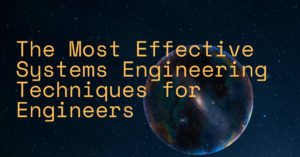
We are frequently charged as engineers with designing and developing complex systems. These systems can range in scope and purpose from small electronic gadgets to big industrial machines, and they can involve various stakeholders such as customers, suppliers, and other internal teams. Engineers must have a profound grasp of systems engineering methodologies to build the system design properly.
A Systems-Based Approach
Adopting a systems approach is one of the essential systems engineering strategies. A systems approach entails seeing the system holistically, considering the overall system, including design, development, testing, and maintenance. This method assists engineers in identifying and comprehending the interdependencies between system components and making educated, interdisciplinary design decisions.
Modelling Mathematically
The use of mathematical modelling is another essential tool in systems engineering. Mathematical modelling allows engineers to depict complicated systems using mathematical equations, allowing them to study and forecast the system’s behaviour. This is especially beneficial early in the design phase when engineers must judge the system’s architecture and components.
Diagrams of Systems
Systems diagrams are also helpful in systems engineering. These diagrams may be used to visually portray the system and its components, making it simpler to grasp the linkages and interactions between them. This is especially helpful when dealing with stakeholders and team members who need a technical background.
Considerations for the Lifecycle
Another essential part of systems engineering is considering the system’s lifetime. The systems engineering process should consider the entire system lifespan, from the initial idea and design stages to development and testing, deployment, and maintenance. This contributes to the system’s design meeting stakeholders’ demands over the entire lifespan of the engineering project.
Systems Engineering Practices and Valispace
Valispace is a valuable tool for assisting engineers in implementing successful systems engineering methodologies. Its distinctive characteristics, such as the ability to link real-time requirements and the system model, enable engineers to work more efficiently and effectively while lowering the risk of mistakes. The Valispace interface is simple and easy to use, allowing engineers to follow the progress and make modifications as required.
The ability to boost traceability throughout the development process is one of the primary benefits of utilizing Valispace in conjunction with systems engineering methodologies. This enables the team to detect possible difficulties early on and make required changes before they become serious concerns.
The use of mathematical models and diagrams to depict the system and its components is another key feature of systems engineering. These models and charts may be used to assess the system’s behaviour and performance and identify potential flaws or areas for improvement. This is especially beneficial early in the design process while the team still defines the system’s needs and specifications.
The systems approach is also critical for ensuring that all stakeholders are considered throughout the development process. This covers the system’s clients and users and any regulatory or compliance organizations that may influence the system’s design and execution. The team can guarantee that the final plan is both functional and compliant by addressing the needs and requirements of all stakeholders early on.
Systems engineering provides a systematic strategy that helps the team manage complexity and minimize risk throughout the system’s lifespan, from early in the development cycle – from design through decommissioning. This is vital for the success of any system development project, but especially for extensive and complex systems like those found in aerospace, defence, and automotive.
Valispace is a valuable tool for assisting engineers in implementing successful systems engineering methodologies. Its unique ability to connect real-time requirements with the system model enables teams to work more efficiently and effectively. Like this, the possibility of risk is reduced, decreasing the possibility of mistakes and guaranteeing that all components and functions are linked to satisfy the project’s objectives. Also, Valispace’s interface is simple and easy to use, allowing teams to track progress and make modifications as required.
Contact our team of experts if you’d like to learn more about how Valispace may assist your team in implementing successful systems engineering methodologies. They will gladly answer any questions and help you get the most out of the tool for your project requirements.

